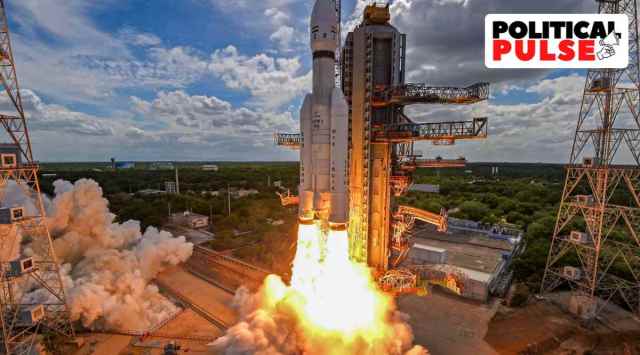India has embarked on its third moon mission with the Indian Space Research Organisation (ISRO) Friday launching the Chandrayaan 3 spacecraft into an orbit around the earth by the heavy lift LVM3 rocket as the first step towards a robotic soft landing on the surface of the moon on August 23. If the soft landing succeeds, India will become only the fourth country in the world – after the United States, Russia, and China – to have achieved it.

Despite the Covid-19 pandemic slowing down the ISRO’s launches as just a couple of missions could be undertaken during 2020-21, the agency has carried out 47 launches using four different launch vehicles since the Modi government came to power in 2014.
In comparison, the ISRO had undertaken 24 launches during the Manmohan Singh government, six during the Atal Bihari Vajpayee government, and five during the P V Narasimha Rao government.
India’s space programme was launched by the Jawaharlal Nehru government in 1962 with the setting up of the INCOSPAR (Indian National Committee for Space Research), which grew to become the ISRO seven years later during the Indira Gandhi regime.
Of the 47 launch missions undertaken by the ISRO in the last nine year, only three failed to put the satellites into their intended orbits. The three failed missions include the maiden flight of the Small Satellite Launch Vehicle, a 2017 PSLV mission carrying a replacement for the navigation constellation when the heat shield protecting the satellite did not open, and a 2021 GSLV mission where inadequate pressure in the hydrogen tank led to the third stage failing to ignite.
While the Chandrayaan 2 mission, launched on July 22, 2019, took off successfully and put an orbiter around the moon, it could not achieve the intended goal of a soft landing on the moon’s surface.
Story continues below this ad
The Union Minister of State for the Department of Space, Jitendra Singh, attributes the increase in the pace of space missions to the Modi government “providing more resources and an enabling policy milieu” to it. “Earlier, we were functioning with limited manpower, limited resource, not allowing others to participate, not allowing funds to come in, the government could not have afforded such huge funds and therefore, in a way, we were actually incapacitating ourselves,” Singh said on being asked about the ISRO’s packed calendar this year.
Apart from enhancing industry partnership for building the launch vehicles, the ISRO has, in recent years, also made changes such as setting up a PSLV integration facility to reduce the time between missions. Earlier, different stages of the PSLV vehicle used to be assembled on the launch pad. Now, it is integrated at the new facility and then brought to the launch pad.
The 24 space missions undertaken by the ISRO during 2004-2014 under the Manmohan Singh government include two of the country’s most iconic scientific missions — Chandrayaan 1 and Mangalyaan.
The Chandrayaan 1 mission, launched in 2008, was instrumental in detecting water molecules on the surface of the moon.
Story continues below this ad
The Mars Orbiter Mission (MOM) or Mangalyaan was launched on November 5, 2013, and after completing 300 days of interplanetary journey, it was inserted into the Martian orbit on September 24, 2014. It demonstrated India’s capability for interplanetary missions. At the time, USA, Russia, and European Space Agency were the only ones to have reached the Mars orbit.
During the tenure of the Modi government, the space telescope called Astrosat was launched, whose data are utilised by scientists across the globe. The anti-satellite weapon and autonomous landing of the reusable launch vehicle have also been demonstrated. The preparations are also currently underway for the first uncrewed Gaganyaan mission and the first solar Aditya L1 mission, which are likely to be launched this year.
There has also been an increase in the revenue generated by the space agency through providing launch services to foreign satellites. The 424 foreign satellites launched by the ISRO include 389 under the current dispensation, which include 101 satellites carried on board a single PSLV mission in 2017.
































